16 Jan 2024 India-Taiwan-China relations in the current geopolitical context and the restoration of democracy in Taiwan.
Source – The Hindustan Times and PIB.
General Studies – International Relations, South China Sea, Importance of Taiwan, China-Taiwan conflict, India’s Act East foreign policy, Taiwan Relations Act, One China Policy, India’s stance on Taiwan issue.
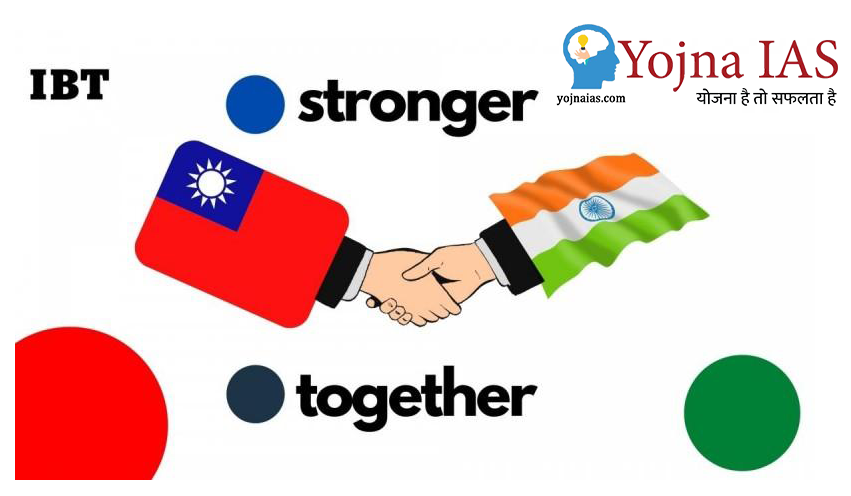
Why in the News ?
- The Democratic Progressive Party (DPP) has created history by winning the presidential elections held in Taiwan in January 2024 for the third time. Lai Ching-te (William Lai) has been elected President of the Republic of China, defeating Hou Yu-yi, candidate of the Kuomintang (KMT), China’s oldest political party, and Ko Wen-je, leader of the newly formed Taiwan People’s Party (TPP).
- The election of Lai Ching-te (William Lai), a staunch opponent of China and a believer in democracy, as the new President of Taiwan is good news from India’s strategic point of view, because China had decided not to vote in his favor in the presidential election. Had appealed. He is the leader of the ruling Democratic Progressive Party (DPP). For India, in the relation between China and Maldives, it is absolutely true that ‘the hunter himself has become the prey here’. The tension of China, which is vocal on Maldives, has increased because someone whom China did not want, Lai Ching Teh has been elected as the new President of Taiwan.
- Maldivian President Mohammed Moizzu won the elections by raising slogans of ‘India Out’ and as soon as he came, he started taking anti-India decisions. China became happy with this. Because Moijju is in favor of China and is strongly anti-India. Moizzu of Maldives, who considered China as his ‘everything’, first visited China after being elected and after being elected as the President of Maldives, he broke the tradition of visiting India first. Maldivian President Mohammed Moizzu went to China and requested China to send a large number of Chinese tourists to Maldives, so that the decline in the number of Indian tourists can be compensated. China also wrote anti-India things in its government newspaper ‘Global Times’. Even indirectly, but pointing towards India, China said that ‘China will not tolerate if anyone interferes in Maldives.’ But the story changed after the election of newly elected President Lai Ching in Taiwan.
- The ideology of his party DPP is based on Taiwanese nationalism, which considers Taiwan’s identity very important.
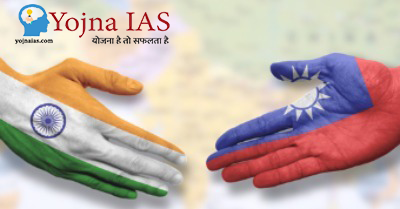
Reverse effect of Beijing’s pressure :
- Lai Ching-te (William Lai) received approximately 40% of the vote, while KMT and TPP candidates received 33% and 26% respectively.
- China has consistently described Lai as a ‘separatist’ and supporter of Taiwan independence. It has also increased military pressure by sending more ships and aircraft to the Taiwan Strait and carrying out mock blockade drills. China has tried its best to intimidate Taiwan with this gray zone warfare tactics.
- In a New Year address just days before the vote, President Xi Jinping said unification was a historical imperative and China would definitely be “unified” with Taiwan. Jinping tried to increase pressure by saying this, but it seems that it has had the opposite effect.
Current meaning of electoral majority :
- In the 2016 and 2020 elections, outgoing DPP chairperson Tsai Ing-wen easily won the majority. Even though the DPP’s share of votes may decline from 57% in 2020 to around 40% in 2024, this is because there was a true triangular election battle this year. Equally important is the fact that the third candidate standing in the election, Ko Wen-je, had been a DPP supporter for many years. In short, anti-KMT votes have consistently been over 50% in voting since 2016.
Development of sense of local identity :
- The 2024 presidential election has confirmed two important trends – The KMT’s message of rapprochement with China is not resonating with the people of Taiwan. And
- There is a growing sense of local identity among Taiwanese people. The Sunflower Movement, which began in 2014 to demand a Taiwanese identity separate from the Republic of China, has deep roots. This means that more and more young Taiwanese want to breathe in the open air and fear that they may not be able to have this freedom if Taiwan merges with China.
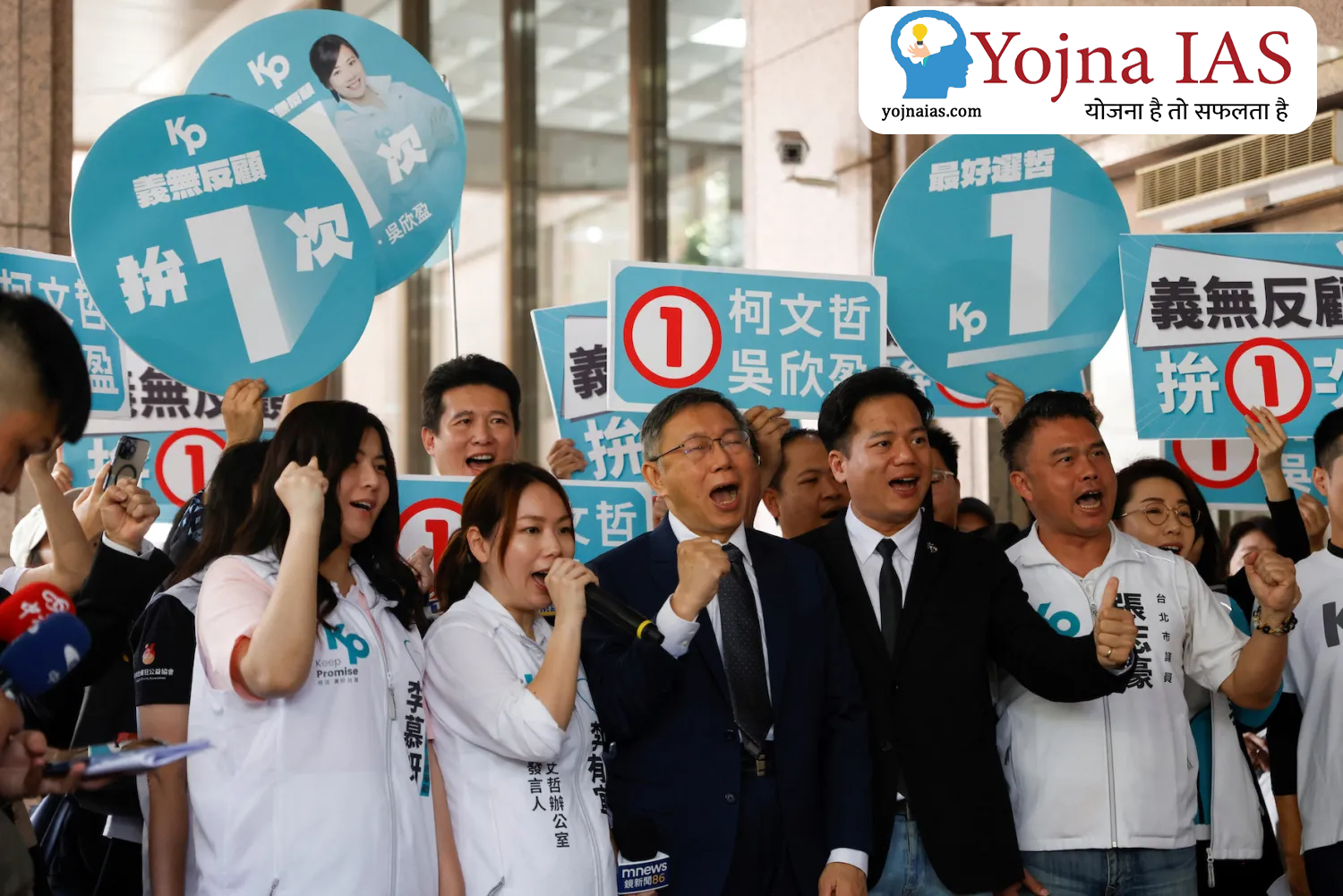
What is the reason for tension between China and Taiwan :
- The island of Taiwan is 161 km off the coast of southern-eastern China. China has always believed that Taiwan is its part which has separated. China also believes that one day Taiwan will be merged into it again. But a large population of Taiwan wants to see Taiwan as a separate country.
- In the 17th century, China was ruled by the Ching dynasty. The Ch’ing dynasty ruled China and Taiwan from 1683 to 1895. China lost to Japan in the war of 1894-95, and as a result, Taiwan became part of Japan.
- The second world war started in the year 1939. This war was fought between the Axis powers (Germany, Italy and Japan) and the Allies (France, Great Britain, America, Soviet Union and to some extent China). After Japan’s defeat, Taiwan was handed over to China’s great politician and military commander Chang Kai Shek. Till then Taiwan was a part of China.
- In 1949, civil war broke out in China against Shek and the Kuomintang Party (KMT). The Chinese Communist Army defeated Chang Kai. After this, the communists under the leadership of Mao Zedong captured power in Beijing and Chang Kai Shek (KMT) along with his associates fled from China to Taiwan. He established his rule over Taiwan. On the other hand, China told the world that Taiwan is its part. Therefore, China continues to rule Taiwan.
- Both KMT and Communists became bitter enemies of each other. However, their relationship started improving in the 1980s. A ceasefire was declared between the two. Presidential elections were held for the first time in Taiwan in 1996. The ruling party won.
- KMT lost its power in Taiwan in the elections held in the year 2000. Taiwan’s new President Chen Shui Bian openly opposed China and described itself as an independent nation. From here again relations between China and Taiwan deteriorated.
China’s difficulty in the current situation :
- Beijing will have to adjust to its worst option for at least the next four years. The young generation of Taiwan does not know much about Unified China. Chinese society has changed fundamentally under Communist rule, making it increasingly difficult for Taiwanese to integrate with China. Many Taiwanese leaders who still support the KMT hold ‘dual citizenship’, but ordinary Taiwanese have nowhere else to go or anywhere else in the country. Beijing is seeing this strengthening of identity as a “zero sum game”. This is also because since 1949, China has not been able to establish its control over Taiwan even for a minute.
Importance of Taiwan from strategic point of view :
- Taiwan is located in a strategically important location in the western Pacific Ocean, adjacent to China, Japan and the Philippines. Its location provides a natural gateway to Southeast Asia and the South China Sea, which are vital to global trade and security.
- It is a major producer of high-tech electronics, including semiconductors, and is home to some of the world’s largest technology companies.
- Taiwan produces more than 60% of the world’s semiconductors and more than 90% of the most advanced semiconductors, semiconductors.
- Taiwan has a modern and capable military that is focused on protecting its sovereignty and territorial integrity.
- Taiwan is a major center of regional and global geopolitics, with the potential to influence the balance of power in the Asia-Pacific region and beyond.
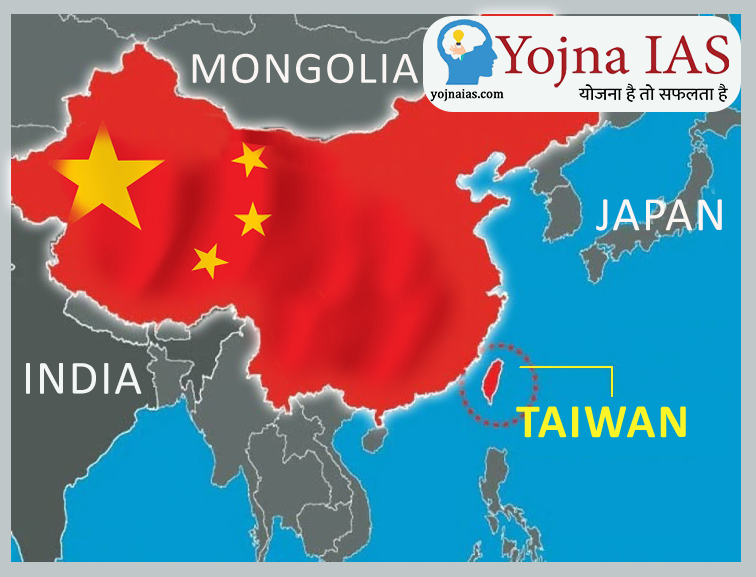
Main reasons for America’s interest in Taiwan :
- Taiwan is made up of a chain of islands that includes a list of friendly territories that the US plans to use as leverage to counter China’s expansionist policy.
- The US does not have official diplomatic relations with Taiwan, but is obliged under US law (Taiwan Relations Act, 1979) to provide the island with the means of its own defense.
- It is by far the largest arms dealer to Taiwan and follows a ‘strategic ambiguity’ policy.
India’s policy towards Taiwan :
India – Taiwan relations :
- India-Taiwan relations have been gradually improving over the past few years, as a part of India’s Act East Foreign Policy. India has sought to develop comprehensive relations with Taiwan in trade and investment as well as cooperation in science and technology, environmental issues and people-to-people exchanges.
- Despite India and Taiwan not having formal diplomatic relations, India and Taiwan have maintained representative offices in each other’s capitals since 1995, de facto functioning as embassies. These offices have facilitated high-level visits and helped strengthen economic and cultural ties between the two countries.
One China Policy :
- Till now, India has been following the ‘One China Policy’, the policy of recognizing Taiwan as a part of China.
- Behind supporting the ‘One China Policy’, India also hopes that China should recognize India’s sovereignty over areas like Jammu and Kashmir.
- India has recently stopped mentioning adherence to the ‘One China Policy’. Although India’s engagement with Taiwan is restricted due to its ties with China, it views Taiwan as an important economic partner and strategic ally.
- India’s growing ties with Taiwan are also being seen as a step to counter China’s growing influence.
- The One China policy recognizes Beijing’s long-standing position that there is only one China and Taiwan is part of it.
- According to the One-China policy – any country wishing to establish diplomatic relations with Beijing must accept its “One China” policy.
- The One China policy is also distinct from the “One China principle”, which emphasizes that both Taiwan and mainland China are inseparable parts of a single “China”.
‘One Country – Two Systems’ Approach :
- The principle of ‘One Country – Two Systems’ was first proposed by Deng Xiaoping as a way to restore relations between the communist mainland and Chinese regions with historically capitalist economies (Taiwan, Hong Kong and Macau) . This system was initially proposed for Taiwan.
- The Taiwanese demanded that the People’s Republic of China (PRC) should be renamed the Republic of China if they were to accept the one country, two systems approach. And,
- Democratic elections will have to be held in mainland China. However it was not accepted by mainland China.
- He suggested that there would be only one China, but that specific Chinese territories such as Hong Kong and Macau could retain their own economic and administrative systems, while the rest of China could continue to use a system of socialism with Chinese characteristics.
- In 1984 this concept was incorporated into the Sino-British Joint Declaration, in which both countries agreed that Britain would hand over sovereignty of Hong Kong to China.
- China is responsible for defense and foreign affairs but Hong Kong runs its own internal security.
San Tong or Three Linkages :
- It was a proposal by the PRC in 1979 to open three direct links between the Taiwan Strait and China, which were the following – postal services, trade and transportation.
- The “Three Links” were officially established in 2008 in an agreement between the Taiwan-based Straits Exchange Foundation (SEF) and China’s Association for Relations Across the Taiwan Strait (ARATS).
- This reduced travel distances and increased trade opportunities for Taiwan.
- This increased economic interdependence between the two countries, but it also raised concerns about Taiwan being drawn into mainland China.

Sunflower Movement :
- In an effort to revive Taiwan’s struggling economy, the KMT eased trade barriers with China in 2010 under the Economic Cooperation Framework Agreement (ECFA).
- This had a deep impact on Taiwan’s economy and it became completely dependent on China. This proved detrimental to Taiwan’s small and medium-sized enterprise manufacturing.
- Activists protested against passing the Cross-Strait Services Trade Agreement (CSSTA) in the legislature without clause-by-clause review by the ruling party Kuomintang (KMT).
- This movement arose out of natural dissatisfaction with the policies of the ruling party.
- The term “sunflower student movement” refers to the protesters’ use of the sunflower as a symbol of hope, as its symbolic flower is heliotropic.
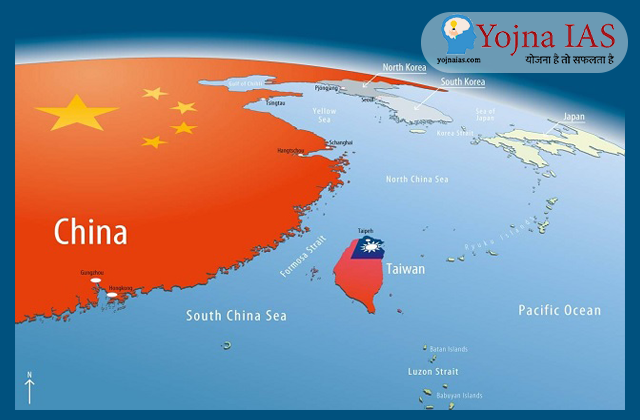
Taiwan’s influence on China :
- Taiwanese have made huge contributions to China’s economic and technological development. This has helped China become the second largest economy in the world.
- This relationship between China and Taiwan can only be classified as commensalism, with Taiwan receiving only some benefits.
- Taiwanese are trying to become independent and invest in other countries like India and New Zealand to prevent them from being completely dependent on China.
Conclusion / Path to solution :
- The Chinese economy is much more integrated into the global economy than the Russian economy. If China wants to invade Taiwan, it will have to carefully consider Taiwan’s sovereignty differences, as in the Ukraine crisis.
- On the global stage, China’s attack on Taiwan will mark a different geopolitical scenario in Asia, because the issue of Taiwan is not limited to the moral question of allowing the destruction of a successful democracy or international morality, but it is a matter of concern. There is also the question of the Asian country’s own sovereignty.
- India may reconsider the ‘One China Policy’ and differentiate its relationship with China from that with Taiwan, just as China is doing with Pakistan-occupied Kashmir (PoK) through its ambitious project China-Pakistan Economic Corridor (CPEC). Is increasing its participation in.
- Taiwan is looking to invest in other countries to reduce its dependence on China, as most Taiwanese have invested in China.
Practice Questions for Preliminary Exam :
Q.1. Consider the following statements in the context of restoration of democracy in Taiwan and India-Taiwan-China relations in the current geopolitical context ?
- The island of Taiwan is 461 km off the coast of south-eastern China.
- Taiwan produces more than 60% of the world’s semiconductors and more than 90% of the most advanced semiconductors, semiconductors.
- The United States is obliged to protect Taiwan under US law (Taiwan Relations Act, 1979).
- The sunflower, the symbolic flower of the student movement, is heliotropic.
Which of the above statement /statements is correct ?
(A) Only 1, 2 and 3
(B) Only 2, 3 and 4
(C ) Only 1 and 4
(D) All of these.
Answer – (B)
Practice Questions for Main Exam :
Q.1. Critically evaluate various aspects of the strategic, economic and strategic dimensions of India’s Look East policy from the perspective of India-Taiwan-China relations in the context of the restoration of democracy in Taiwan and the post-Cold War international scenario.
Qualified Preliminary and Main Examination ( Written ) and Shortlisted for Personality Test (INTERVIEW) three times Of UPSC CIVIL SERVICES EXAMINATION in the year of 2017, 2018 and 2020. Shortlisted for Personality Test (INTERVIEW) of 64th and 67th BPSC CIVIL SERVICES EXAMINATION.
M. A M. Phil and Ph. D From (SLL & CS) JAWAHARLAL NEHRU UNIVERSITY, NEW DELHI.


No Comments